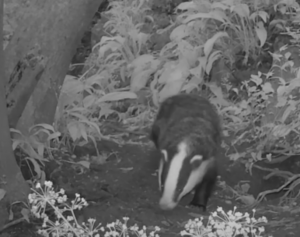Facts about badgers, a Woodlands TV film

The badger (strictly speaking the european badger) arrived in this country, like everything else, as the ice retreated some thousands of years ago. It is our largest land predator, others such as the wolf are no longer with us - though some would support their reintroduction as part of rewilding programs.
Whilst badgers are predators, they are, in fact, omnivores - eating both plant and animal material. Much of their diet is earthworms, though they are not averse to small mammals such as mice, rats and hedgehogs! Whilst badgers tend to make their home (setts) in woodlands, they will travel to open fields and pastures in search of food, digging for grubs [for example, chafer larvae].
A badger sett is a complex, extensive engineering feat accomplished by using their powerful front limbs and claws. They dig down and then drag the earth out of the tunnels by moving backwards with the soil under their chin and then deposit it in a ‘spoil heap’. The presence of a spoil heap is a good indication of a badger sett in your woodland. If a colony is well established there will be a main sett, but also an ‘annex sett', and possibly even smaller setts away from the main sett.
Recently Woodland TV filmed Adrian Coward from the Somerset Badger Group, who explains in details the nature and relationship of these setts and how badgers recognise their ‘family members’ and how they mark their territory. They move around their territory along well defined paths.
Whilst we know a lot about how badgers move through their home territories, little was known about any long distance movements. To investigate such movements, scientists set up a study in County Kilkenny (Ireland). It was one of the largest badger studies of its type, The study spanned a large area and some four years ,and 'followed' some 900+ badgers. They found that whilst most badgers only moved 2 to 3 kilometres from their sett, some travelled 7.5 km and the longest distance travelled by a badger was 22 km. If animals can move around and meet with other populations, this can promote outbreeding.
Learning about these 'lengthier' movements may be a useful contribution in the discussion of badgers and bovine tuberculosis - which is also discussed in the Woodlands TV film ‘Facts about badgers’, and the topic has featured in other woodland blogs.
Curious fact : The French call a wet shaving brush blaireau or “badger", because quality brushes use badger hair.
Apart from viewing Woodlands TV on this site, it may also be viewed on YouTube : www.youtube.com/@WOODLANDSTV
82K subscribers
482 videos
15,896,142 views
Joined 9 Jul 2008
United Kingdom
Comments are closed for this post.
